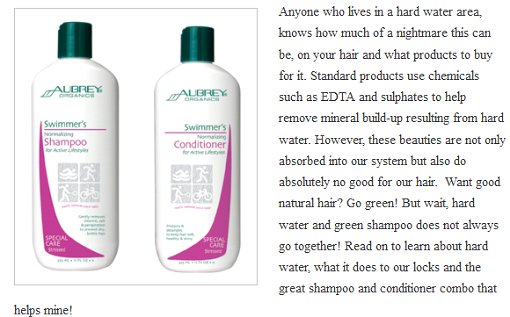Health and Beauty
Non Toxic Hair Care For Hard Water Areas
By Julia Edgely

MY STORY
Hair care was the first thing I changed when clearing out my personal care products. At first I thought I would just have to accept that my hair was never going to feel soft as it once did. On so many websites, I had read that going low poo (limited use of shampoo) or no poo (cutting out shampoo altogether) meant that hair felt like “real hair”, which in my case was like a horse’s tail! So I continued on this path.
After a while, the frizz arrived and my good intentions were most definitely tested. I assumed that my hair would be dry, but it didn’t feel dry at all, just fluffy. The ends were the worst, fluffy, big and frazzled looking. No matter how much oil or various treatments I used, the fuzzy hair was most definitely not going away. My colour was also looking very dull.
It was whilst making myself a cuppa one day, that I noticed the cup was full of white flakes and it clicked! The flakes were chunks of mineral deposit that built up in my kettle from hard water. It was also around the taps and in that moment I realised, in my hair! I now knew what to do, to sort out my hair. Before I could do that though, I seriously needed to de-scale my kettle.
To be honest, I felt totally out of my depth when researching products. I decided to contact one of my natural beauty gurus.
The general consensus was to use a water filter to minimise the amount of minerals building up. I was also recommended a shampoo and conditioner that could help with my situation – Aubrey Organic Swimmers Shampoo and Condititoner.
HARD WATER FACTS AND EFFECTS ON OUR HAIR
Hard water refers to the level of mineral content in water. The higher the mineral levels are, the harder your water is. The minerals we are talking about are calcium and magnesium, with a few others such as bicarbonates thrown in there. These minerals cause the cuticle, the outer layer of our hair strand to raise. Raised cuticles means dull, fluffy, tangle prone hair. Products will also over time become trapped in the raised cuticles, leading to product build-up. Normally, a good dose of Apple cider vinegar would make the cuticle lie flat, but this is not enough in a hard water area.
“Standard” shampoo uses ingredients such as, sulphates, silicones and EDTA to hide the effect of hard water. However, these ingredients are not without their drawbacks. EDTA & Sulphates are penetration enhancers, meaning they increase the permeability of our skin leaving our system vulnerable to external influences, such as toxic chemicals and pollution. Sulphates strip our natural oils which work with our immune system and also conditions our hair. Silicones, finally, cover each hair strand in a plastic layer, masking damage underneath. Follicles also become clogged, impeding hair growth. If you have thinning hair or you hair quality has reduced recently, as well as seeing a health practitioner, look at the products you use. To see what these ingredients do once inside our bodies, check out EWG Skin Deep, cosmetics database!
In my case, as as you can see in pictures below, it was the ends of my hair that showed the tell tale signs of hard water and mineral build up. Although fluffy and even dry looking, my hair was soft to touch. I noticed that when dry, it was very straight and my hair colour turned a mousey shade. I do not colour my hair and I am fortunate that my hair colour is still quite vibrant, although now quickly turning grey. However, a mineral build-up will either dull your colour or make coloured hair brassy. So if you are not sure if you suffer from the side-effects of hard water, see how your hair reacts to a deep conditioning treatment. If there are still signs of frizz, look at your water supply.
There are websites available showing water quality in your region. I discovered that the water in my area, in red, was extremely hard.

AUBREY SWIMMER’S SHAMPOO & CONDITIONER
The shampoo and conditioner, along with delivery from the UK costs about €35, so not the cheapest of hair products but it does last a long time.
The key ingredients are rice bran and quinoa protein. Both are used for their chelating properties and for smoothing the hair follicles. The latter adds to increase hydration and give super shiny hair. If you suffer with porous hair, these ingredients will also benefit you.
THE RESULTS
Both products smell divine, almondy and sweet. Remember in a hard water area, foam is a little shy to make an appearance. First I used the shampoo and then the conditioner. The texture of the conditioner took me by surprise, in a good way. It was thick, very creamy and had the slippery texture, similar to silicone based products but obviously without the silicone. I followed my usual routine by, leaving it in for 5 minutes and then rinse. The first time I used the products I let my hair to air dry and even slept on it whilst still a little damp.
When I woke the next day, I was very impressed with how my hair felt and looked. I was back in love with my hair. There was volume in my roots which I never had before and my hair was super soft to touch. Even my friends noticed how good my hair was looking.

In the first image on the left, taken after the first time I used the products, my hair was still a little fluffy at the ends, and after one month, I really could see an incredible difference. I find the best way to use the two is to apply the conditioner first to the ends, leave for 15mins or longer and then wash out. Sometimes, I reapply a very small about of conditioner just to the very tips of the hair and rinse thoroughly. So in a hard water area, Aubrey Organic is the way to go!
Original version HERE
Edited by The Riviera Woman



